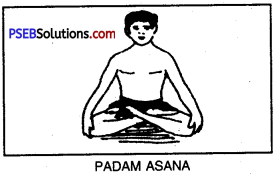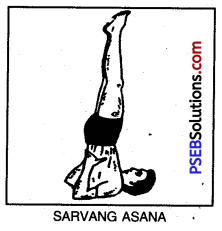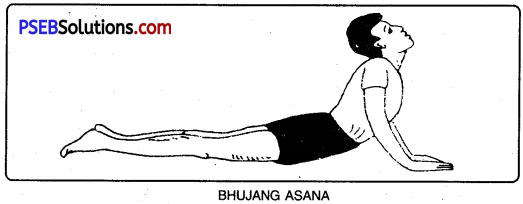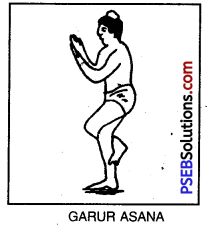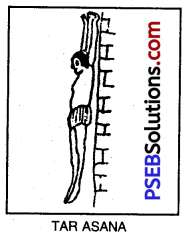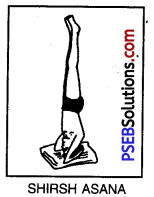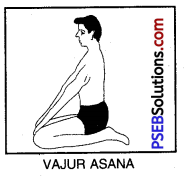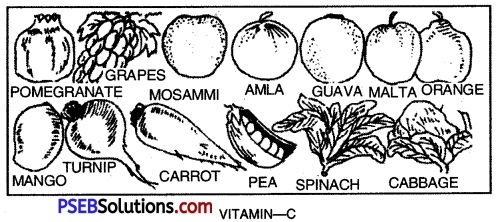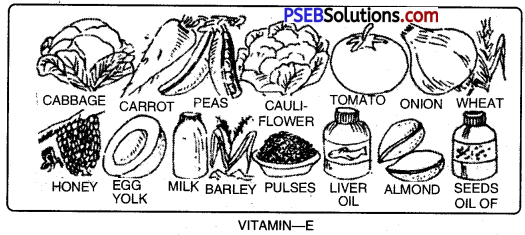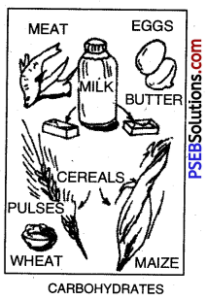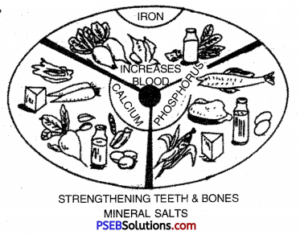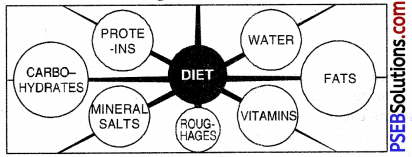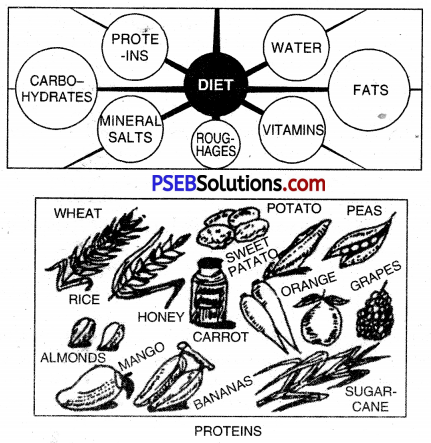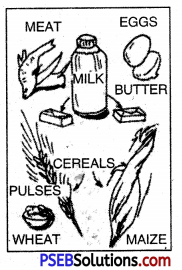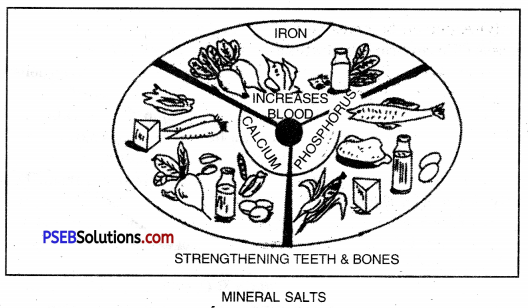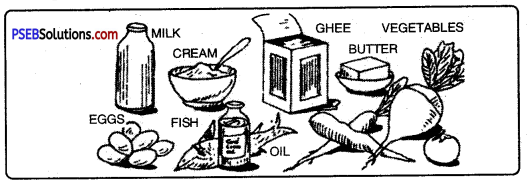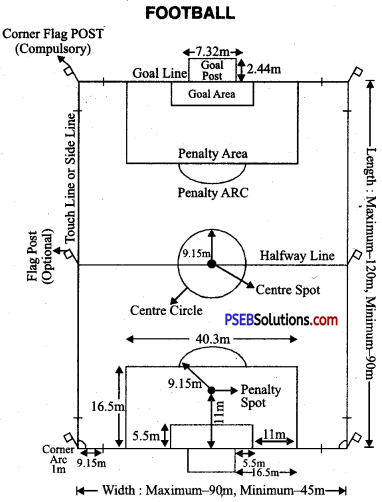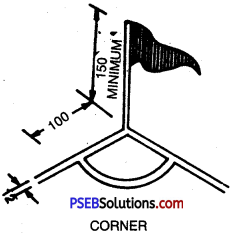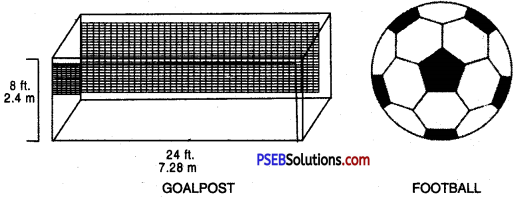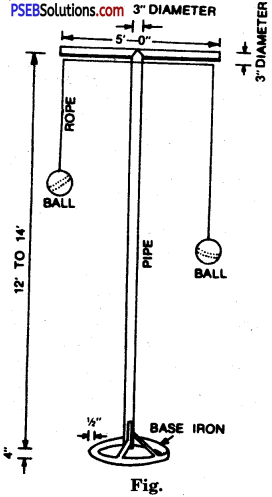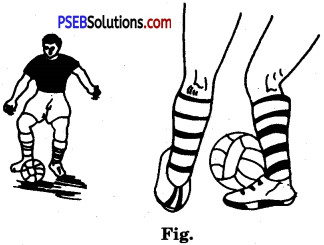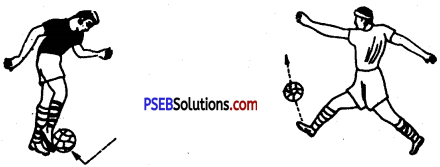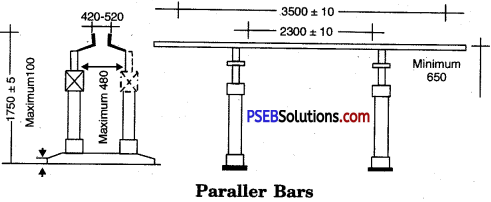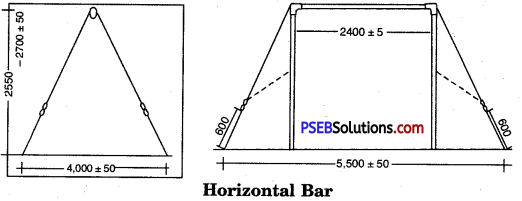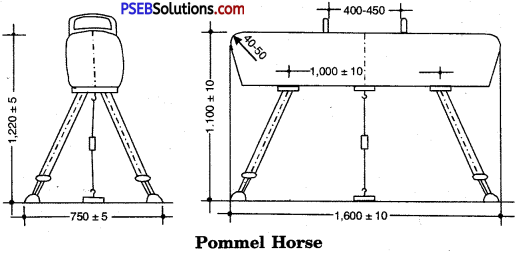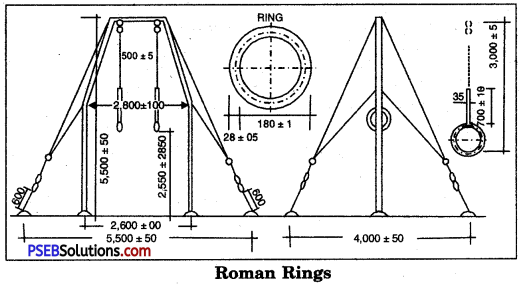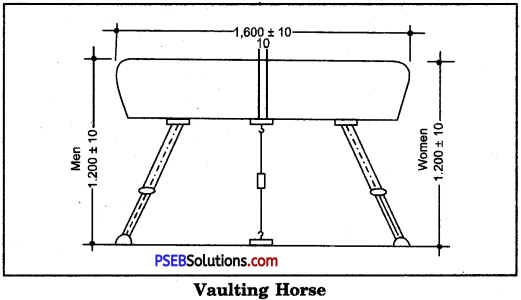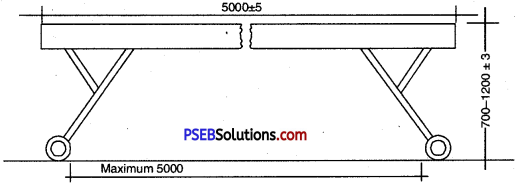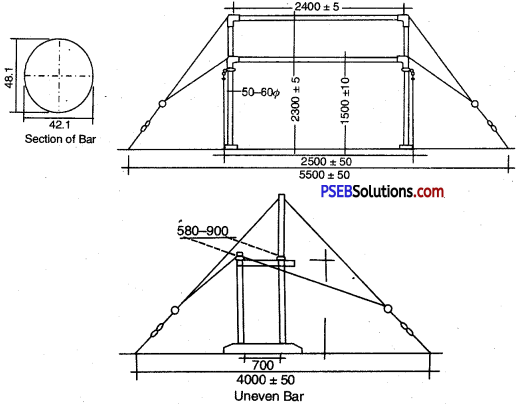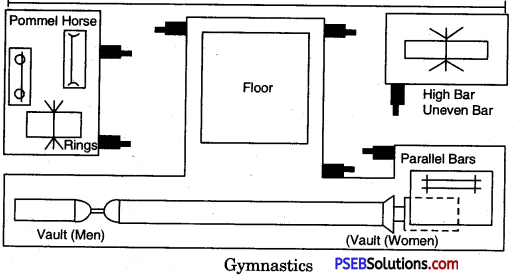Punjab State Board PSEB 10th Class Agriculture Book Solutions Chapter 1 Institutions: Allied to Agriculture Textbook Exercise Questions and Answers.
PSEB Solutions for Class 10 Agriculture Chapter 1 Institutions: Allied to Agriculture
Agriculture Guide for Class 10 PSEB Institutions: Allied to Agriculture Textbook Questions and Answers
(A) Answer in one-two words:
Question 1.
Which central agency is responsible for the procurement of agricultural produce in Punjab State?
Answer:
PAIC, Food Corporation of India.
Question 2.
Which Corporation carries out the export of agricultural produce?
Answer:
Punjab Agri Export Corporation Limited (PAGREXCO).
![]()
Question 3.
Name the organizations set up jointly by the Punjab Agro Industrial Corporation and Punjab Mandi Board.
Answer:
Punjab Agri Export Corporation Limited (PAGREXCO).
Question 4.
When did the Punjab Horticulture Department came into being?
Answer:
It came into being in 1979-80.
Question 5.
Who is responsible for research, teaching mid extension of Animal Husbandry and Fish farming, in Punjab?
Answer:
Guru Angad Dev Veterinary and Animal Sciences University (GADVASU).
Question 6.
Which Co-operative is engaged in fertilizer production and distribution?
Answer:
Indian Farmers Fertilizers Cooperative Limited (IFFCG).
Question 7.
Which department implements schemes of National Horticulture Mission?
Answer:
Department of Horticulture.
Question 8.
How many field laboratories of NSC are functional to assess the quality of seeds?
Answer:
There are five field laboratories.
![]()
Question 9.
Which corporation involves farmers in seed production?
Answer:
Punjab State Seeds Corporation Limited (PUNSEED).
Question 10.
Which organization is responsible for procurement and marketing milk in Punjab?
Answer:
Milkfed.
(B) Answer in one-two sentences:
Question 1.
Which agriculture items are exported by the Punjab Agro Export Corporation Ltd.?
Answer:
Punjab Agri Export Corporation Limited (PAGREXCO) mainly exports the following agricultural items:
- Fresh and processed fruits.
- Export of vegetables and flowers.
- Other agricultural products.
Question 2.
What facilities are provided to farmers by IFFCO?
Answer:
This corporation helps the farmers to raise their economical status. This corporation also help in marketing of fertilizers and also use various extension activities so that new agricultural techniques could reach the farmers. Facility of free testing of soil and water is also provided to farmers.
![]()
Question 3.
What is the main function of PAIC?
Answer:
Main function of Punjab Agro Industries Corporation Limited (PAIC) is to help in marketing of the agricultural produce, buying the agricultural produce and help in diversified farming through contract farming. This Punjab Agro Foodgrain Corporation (PAFC) procures wheat and rice for food corporation of India.
Question 4.
State any two activities carried out by Punjab Co-operative Department.
Answer:
Activities carried out by Punjab Cooperative Department:
- To provide self employment opportunities to rural women under the scheme named “Mai Bhago Woman Empowerment Scheme”.
- To fulfil the supply of essential domestic for rural areas through cooperative societies.
Question 5.
How is MARKFED serving the farmers?
Answer:
Markfed is making available agricultural seeds, fertilizers, pesticides etc. at subsidized rates to the farmer. It also help in marketing and processing of the produce.
Question 6.
What are the three main different tasks performed by PAU?
Answer:
Punjab Agricultural University has the following three functions:
Research in the field of agriculture and allied fields. Education related to agriculture i.e. teaching and extension.
Question 7.
Write briefly note on FAO.
Answer:
This organisation was established in 1943. It is an agency by United Nations with main purpose to defeat hunger and starvation in the world. Its headquarters are in Rome (Italy). Its main objective is food security for each and every person of the world. It also act to save the natural resources.
Question 8.
What was the objective behind establishing the WTO?
Answer:
Main objective behind the formation of WTO:
- To nullify the restrictions, bans on the sale of agricultural produce.
- To reduce the subsidy for exporting agricultural produce.
- To stop or to reduce the subsidy given to farmers for their agricultural needs.
- To abolish the quota system for exporting and draft a working policy for export.
![]()
Question 9.
Why was the ATMA established?
Answer:
This agency is formed to coordinate various activities related to development and extension of Agricultural activities, performed and arranged by agriculture and allied departments. Agricultural Technology Management Agency (ATMA) has been established by department of agriculture.
Question 10.
What was the purpose behind setting up Punjab Khadi and Gram Udyog Board?
Answer:
The main objective of forming Punjab Khadi and Gram Udyog Board is to facilitate and provide help for rural industry and other.
(C) Answer in five-six sentences:
Question 1.
Briefly describe the Department of Agriculture.
Answer:
Department of agriculture was established in 1881. This department has played an important role in the development of agriculture in Punjab. This department enacts as a link between agricultural scientists and farmers. This department is responsible for implementing all the schemes related to agriculture. This department has established laboratories for testing soil, seed, fertilizers, edible substances etc. ATMA has been formed to co-ordinate the activities related with development and extension of agriculture. .
![]()
Question 2.
Highlight the reason for establishing the Punjab State Farmers Commission.
Answer:
Main objectives of farming Punjab Farmers Commission are:
- To evaluate, present scenario related to agriculture and allied sectors in the state and that of rural infrastructure.
- To give suggestions for sustainability of the cropping system and making economy strong.
- To give directions for increasing agriculture yield, taking care of the produce after harvesting and developing new techniques for processing at low cost.
- To provide financial help for social and economical issues related to rural areas e.g. increase in loans, suicidal incidences, rural unemployment. Suggesting suitable policies to the government on the above said issues.
- To suggest suitable policies and solutions to the government on the basis of meetings held with farmer organisations, unions and their representatives for discussing their problems, difficulties and demands.
Question 3.
Discuss the objectives of the PAIC.
Answer:
Punjab Government established PAIC in the year 2002. Main objectives are given ahead:
- To market the quality agricultural produce.
- To purchase agri produce and to encourage diversified farming through contractual fanning.
- To procure wheat-rice from the farmers.
Question 4.
Write a short note on GADVASU.
Answer:
Guru Angad Dev Veterinary and Animal Sciences University (GADVASU) was established in 2005. It works for research, education and extension of livestock, pigs, rabbits, chicken, sheep, goat, horses and fishes etc. 24 x7 hr. facility of Hospital is available, for sick small and large animals. Here Veterinary doctors are well trained and educated. There are four Colleges under the Veterinary University namely Veterinary college, College of Dairy Science and Technology, college of Fishery, college of Veterinary Poly-technic.
There are two departments by I.C.A.R. namely surgery and gynaecology in the Veterinary University, which are nominated as super speciality training centers. There are three Regional research and training centres at Kaljharani (Bhatinda), Booh (Taran-taran) and Talwara (Hoshiarpur) under the university. This university in Punjab is the top most organisation providing all type of facilities and suggestions related to veterinary and animal husbandry in concerned.
Question 5.
Which facilities are provided for dairy development by the Dairy Development Board?
Answer:
Department of dairy development provides training for activities and works related to dairy. Department helps the beneficiaries to get subsidized loans from banks. Subsidy is also provided for some of the works which are given below:
- Help in getting subsidy for constructing shed and also provide technical know how.
- Providing help to purchase milch animals and giving back 75% of insurance amount for three years to the beneficiaries.
- Providing subsidy for purchase of bulk milk coolers.
- Giving subsidy for milking machine and fodder harvester and fodder cutter machine.
- Providing subsidy for establishing Dairy service centre for giving machines on rent like automatic dispensing machine, total mix ration wagon etc.
![]()
PSEB 10th Class Agriculture Guide Institutions: Allied to Agriculture Important Questions and Answers
Multiple Choice Questions
Question 1.
In Agmark Laboratory are tested for their quality.
(a) Turmeric
(b) Honey
(c) Chilli
(d) All.
Answer:
(d) All.
Question 2.
Which type of country is India?
(a) Agriculture based
(b) Sports based
(c) Industry based
(d) None.
Answer:
(a) Agriculture based
Question 3.
Punjab Agricultural University came into being in
(a) 1962
(b) 1971
(c) 1950
(d) 1990.
Answer:
(a) 1962
![]()
Question 4.
Rate of subsidy fixed by WTO is
(a) 5%
(b) 25%
(c) 10%
(d) 19%.
Answer:
(c) 10%
Question 5.
Where is Guru Angad Dev Veterinary and Animal Sciences University (GADVASU) located?
(a) Ludhiana
(b) Bathinda
(c) Patiala
(d) Jalandhar.
Answer:
(a) Ludhiana
Question 6.
Name the co-operative organisation for purchasing and marketing of milk in Punjab.
(a) Markfed
(b) Housefed
(c) Milkfed
(d) Sugarfed.
Answer:
(c) Milkfed
Question 7.
In which city Punjab Agricultural University is located?
(a) Ludhiana
(b) Palampur
(c) Hisar
(d) Kamal.
Answer:
(a) Ludhiana
Question 8.
What is the name of website of Guru Angad Dev veterinary and Animal Sciences University?
(a) www.gadvasu.xn
(b) www.pddb.in
(c) www.ndri.res.in
(d) www.pau.edu.
Answer:
(a) www.gadvasu.xn
![]()
Question 9.
What is the name of website of Punjab Dairy Development Board?
(a) www.gadvasu.in
(b) www.pddb.in
(c) www.ndri.res.in
(d) www.pau.edu.
Answer:
(d) www.pau.edu.
Question 10.
In which city Himachal Pradesh Agriculture University is located?
(a) Ludhiana
(b) Palampur
(c) Hisar
(d) Kamal.
Answer:
(d) Kamal.
Question 11.
In which city Haryana Agricultural University is located?
(a) Ludhiana
(b) Chandigarh
(c) Hisar
(d) Patiala.
Answer:
(c) Hisar
Question 12.
Which product is procured through Milkfed in rural areas?
(a) Wheat
(b) Cotton
(c) Milk
(d) Fruit.
Answer:
(c) Milk
![]()
True or False
1. ATMA has also been setup under the department of Agriculture.
Answer:
True
2. Multispeciality hqspital at GADVASU is 24 x 7 hospital, catering to sick animals.
Answer:
True
3. Official website of GADVASU is www.gadvasu.in.
Answer:
True
4. There are eight dairy training and extension centres in Punjab.
Answer:
True
5. Punjab State Seed Corporation Limited started operating from 1990.
Answer:
True
![]()
Fill in the blanks
1. Punjab Govt, constituted the …………… commission under the chairmanship of Dr. G.S. Kalkat.
Answer:
Punjab State Farmers
2. KRIBCO was established in ……………. .
Answer:
1980
3. Headquarter of FAO is situated in ……………. .
Answer:
Rome (Italy)
4. National Seeds Corporation was setup in the year ……………. .
Answer:
1963
5. Soil and water conservation department came into being in …………… .
Answer:
1969.
![]()
Very Short Answer Type Questions
Question 1.
What type of country is India?
Answer:
India is country based on Agriculture.
Question 2.
Who is the chairman of department of agriculture?
Answer:
Director of department of agriculture.
Question 3.
Which lab is there to test honey, turmeric, chilli etc. established by department of agriculture?
Answer:
Agmark laboratory.
Question 4.
Who is the head of department of agriculture and who is head in district?
Answer:
Head of department of agriculture is ‘The director of the department’ and in district head is the ‘chief agricultural officer’.
Question 5.
Which agency has been set up by department of agriculture to coordinate various activities related to development and extension of agriculture and allied departments?
Answer:
ATMA, Agricultural Technology Management Agency.
![]()
Question 6.
When was Punjab Agriculture University established?
Answer:
In the year 1962.
Question 7.
Which colleges were the Model for establishing P.A.U.?
Answer:
P.A.U. was established on the Model of American Land Grant Colleges.
Question 8.
For how many hours, health facility is available for animals in the veterinary university?
Answer:
For 24 x 7 hours.
Question 9.
How many colleges are there under veterinary university?
Answer:
Four.
Question 10.
Which of the two departments of the veterinary university ; have been nominated by ICAR as super speciality training centres 1 for 15 years?
Answer:
Department of surgery and gynecology.
Question 11.
When was department of horticulture established?
Answer:
In the year 1979-80.
![]()
Question 12.
Give one aim of department of horticulture.
Answer:
To increase area under horticulture crops.
Question 13.
When was national horticulture mission launched by department of Horticulture?
Answer:
Since 2005-06.
Question 14.
How many dairy training and extension centres are being run by department of dairy development Punjab?
Answer:
Eight centres.
Question 15.
What is the period of training given for self employment by department of dairy development?
Answer:
Two weeks.
Question 16.
How much amount is returned to the beneficiary for the cost of insurance for three years spent for purchasing milch animals?
Answer:
75%.
Question 17.
How much subsidy is given for the purchase of milking machine and fodder harvester and fodder cutter machine?
Answer:
50%.
![]()
Question 18.
In which year department of fisheries Punjab has established fish farmer development agency?
Answer:
In the year 1975.
Question 19.
For how many days, fish farming training is provided by department of fisheries for free?
Answer:
For five days.
Question 20.
When was soil and water conservation department established?
Answer:
In the year 1969.
Question 21.
What is the name given to head of the department of soil and water conservation? •
Answer:
Chief Soil Conservator of Punjab and at block level soil conservation officer.
Question 22.
When did department of cooperatives come into existence and after which act?
Answer:
It came into existence in 1904 after enactment of act of cooperative.
Question 23.
Which department is running the free of cost Bhai Ghanyia Health Scheme’?
Answer:
Department of Cooperation.
Question 24.
Processing milk from rural areas, its processing and marketing in the city, who does it?
Answer:
Milkfed.
![]()
Question 25.
What is full form of IFFCO?
Answer:
Indian Farmers Fertilizer Cooperative Limited.
Question 26.
Give full form of KRIBCO.
Answer:
Krishak Bharti Cooperative Limited.
Question 27.
Write full form of NFL?
Answer:
National fertilizer limited.
Question 28.
Who was head of Punjab state farmers commission?
Answer:
Dr. G. S. Kalkat.
Question 29.
When was Punjab seeds corporation limited established?
Answer: In 1976.
Question 30.
When was National seeds corporation limited established?
Answer:
In 1963.
Question 31.
How many types of certified seeds of how many crops are being produced by National Seeds Corporation Limited?
Answer:
600 types of certified seeds of 60 crops.
![]()
Question 32.
How many laboratories have been established by NSC as quality control measure for testing standard of seeds?
Answer:
There are five laboratories.
Question 33.
Which corporation is working on tissue culture?
Answer:
National Seed Corporation.
Question 34.
Which corporation does procure wheat-rice for FCI7
Answer:
PAIC through its subsidary branch PAFC.
Question 35.
Where is the main office of ICAR? Or In which city Head office of Indian Council for Agricultural Research (ICAR) is located?
Answer:
New Delhi.
Question 36.
How many institutes and agricultural universities are working under ICAR?
Answer:
101 institutes and 71 state agricultural universities.
Question 37.
When was NABARD established?
Answer:
In 1982.
![]()
Question 38.
Where is Head office of NABARD?
Answer:
In Mumbai.
Question 39.
When was GATT established?
Answer:
In year 1948.
Question 40.
How many members are there in GATT?
Answer:
Initially were 23 and now there are 164 members.
Question 41.
Give full form of GATT.
Answer:
General Agreements on Tariff and Trade.
Question 42.
What is changed named for GATT?
Answer:
World Trade Organisation.
Question 43.
What is rate of subsidy as fixed by WTO?
Answer:
10%.
Question 44.
Give full form of FAO.
Answer:
Food and Agricultural Organisation.
![]()
Question 45.
When was FAO established?
Answer:
In 1943.
Question 46.
Where is head office of FAO?
Answer:
Rome (Italy).
Question 47.
What is the full form of ICAR?
Answer:
Indian Council of Agricultural Research.
Question 48.
Write full form for W.T.O.?
Answer:
World Trade Organisation.
Question 49.
How much subsidy is given on purchase of milking machine by Department of Dairy Development?
Answer:
50%.
![]()
Short Answer Type Questions
Question 1.
Give main objectives of department of Horticulture. Or Write any four functions done by Department of Horticulture Punjab.
Answer:
Main objectives of department of horticulture are:
- To increase area under cultivation of horticulture.
- To provide high standard seeds for vegetables and also to provide nursery plants for fruits.
- To extend and help in reaching technological information upto villages and farmers about horticultural crops.
- To provide economic help for exhibition of plants and vegetables.
Question 2.
Name four colleges of GADVASU.
Answer:
- Veterinary College,
- College of Dairy science and technology
- College of Fisheries
- Veterinary polytechnic.
Question 3.
What do you know about National Horticultural Mission run by department of horticulture?
Answer:
Department of horticulture started natioqal horticulture mission in 2005-06. This mission helps farmers for pack house, net house, making poly house, to get more profit by establishing processing units, training farmers.
![]()
Question 4.
Give objectives of animal husbandry department?
Answer:
- To give improved feeding and management for livestock, (e.g. vaccination and de-worming etc.)
- To increase genetic potential and improvement in breeding.
- To provide extension services.
Question 5.
What are the facilities given to farmers by MARKFED?
Answer:
Markfed helps farmers:
To get agri seeds, fertilizers, pesticides etc. at subsidised rates. It also help in processing and marketing of agricultural produce.
Question 6.
What are the main objectives of Punjab seeds corporation limited? When was it established?
Answer:
This corporation was established in 1976. Its main objectives are to provide better quality seed at lower cost to the farmers and to create infrastructure for seed production and storing so as to cater the increasing demand of seeds.
![]()
Question 7.
What are the facilities given to farmers by co-operative department, Punjab?
Answer:
The Co-operative Department played an important role in bringing T Green Revolution in the state. Marketing of the agricultural produce, j production, purchase and marketing of milk in the cities.
Long Answer Type Questions
Question 1.
What do you know about department of fisheries?
Answer:
This is one of the oldest department in Punjab. This department takes care of the fish as in rivers, streams lakes, notified water bodies. Responsibility of this department lies with Assistant Director fisheries at district level. This department earns by lending these resources on rent/lease.
In the year 1975 fisheries department Punjab has established fish farmers development agency to encourage fish farming and new fish breeding farms were also built. This way there was a revolution in fish farming. This department organises a training session for fish farming free for five days in every month at district level. This department grants subsidy and also provide extension services.
Question 2.
Give brief information about department of Dairy development.
Answer:
Department of dairy development was established for all round development of dairy sector in Punjab. Head of the department is Director dairy development and at district level Deputy Director dairy development. This department provides training for dairy farming and also doing the work of extension and development of dairy farming. There are eight dairy training and extension centres in Punjab under this department.
Department provides free training for two week of self-employment training, six week dairy business related to various jobs of dairy farming. Camps are organised in villages to instruct villagers about benefits of dairy farming. Farmers are encouraged to adopt this business. Consumers in the city are made aware of the quality testing measures of milk and also about the possibilities of adultration of milk by organising camps. Trained beneficiaries are helped to get loans from bank, they are also provided with technical information and subsidy.
Question 3.
Write the name of 10 helpful institutions related to Agriculture.
Answer:
- Department of Agriculture
- Animal Husbandry Department
- Department of Dairy Development.
- Department of Horticulture.
- Department of Fisheries
- Department of Cooperation.
- Punjab Agro-industries Corporation Limited.
- Punjab State Seed Corporation Limited.
- National Seed Corporation.
- Indian Council of Agricultural Research.





